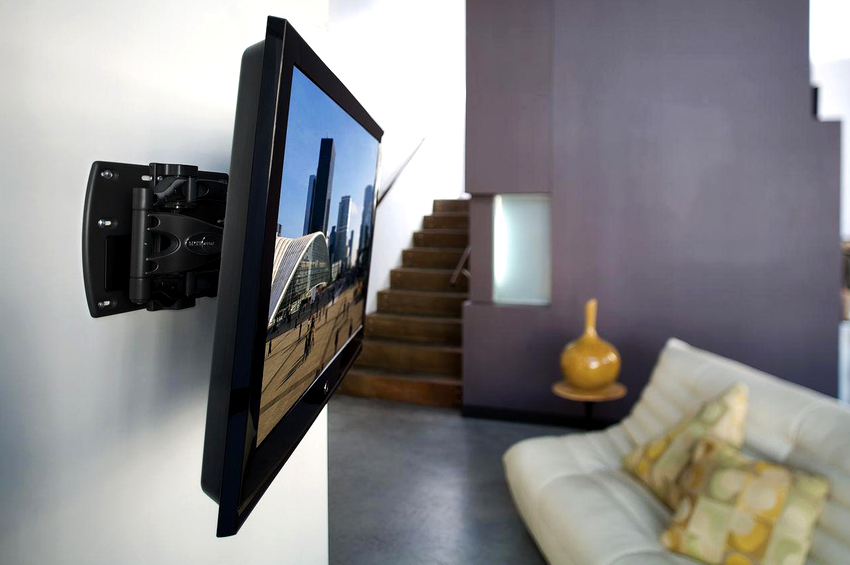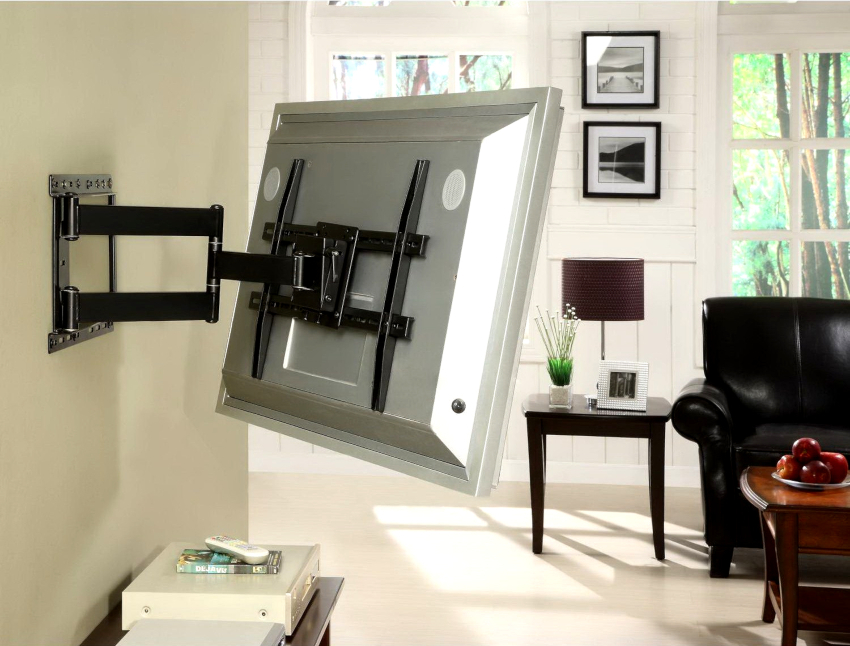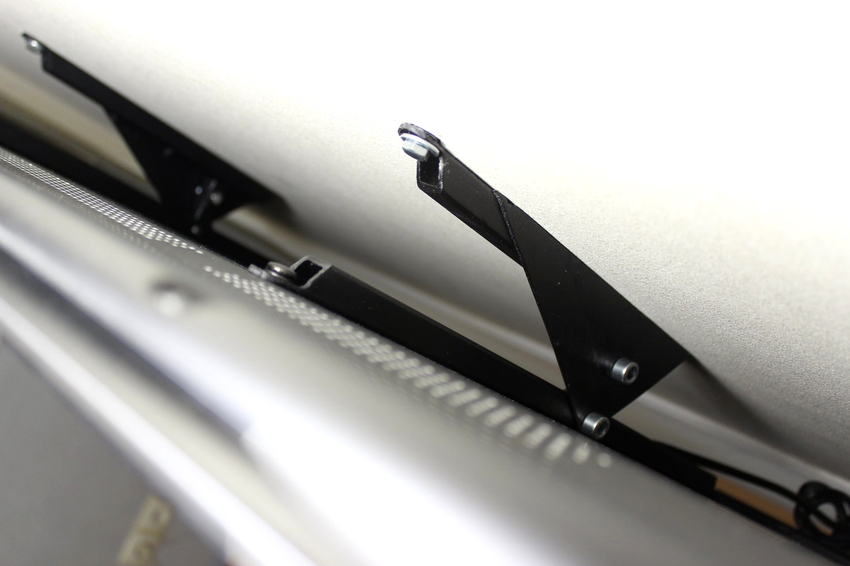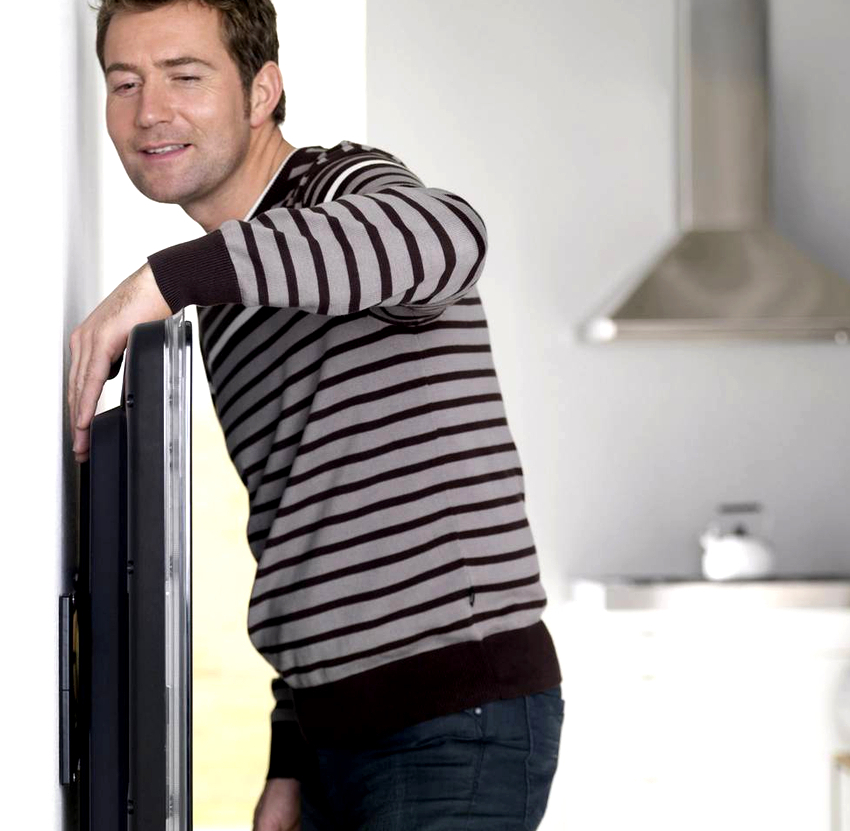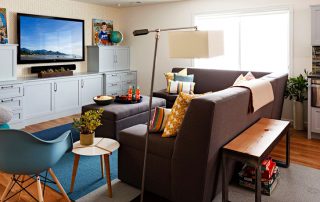CRT TVs, which required a pedestal, and therefore a lot of free space, are long gone. Modern flat screens look much more attractive on the wall, where they do not take up extra space and provide convenient viewing of your favorite films. The installation process involves more than just drilling holes in the wall. Before you hang the TV on the wall, you need to choose the optimal place, height and suitable bracket.
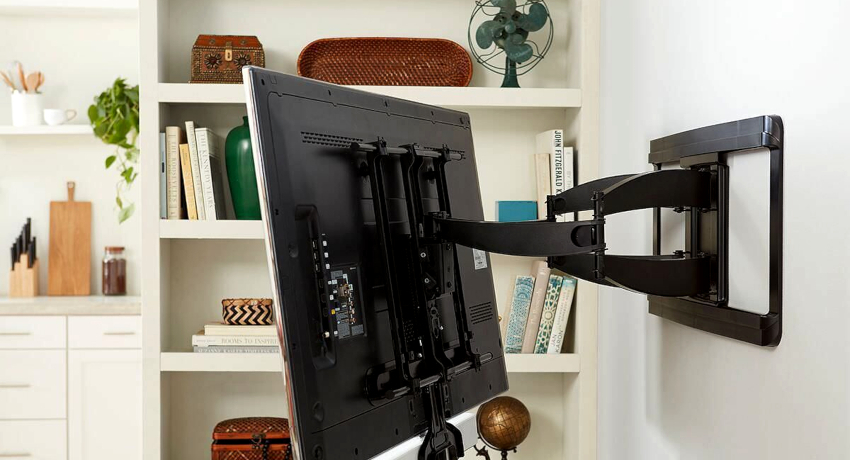
To hang TV set on the wall, you need to choose a suitable bracket, the optimal place and height
Content [Hide]
- 1 The main advantages and disadvantages of installing the TV on the wall
- 2 At what height do you hang the TV depending on the type of room
- 3 How to hang a TV on the wall: choosing the optimal distance, rules and recommendations for placement
- 4 Brackets for installing a TV on the wall: types, advantages and disadvantages
- 5 How to hang your TV on a drywall and other types of materials
- 6 How to mount a TV on the wall: photo in the interior
The main advantages and disadvantages of installing the TV on the wall
Before you mount the TV on the wall, you need to understand that such an arrangement has not only advantages, but also some disadvantages. It depends not so much on the size of the device as on the area of the room in which the installation is planned, as well as on the presence of small children and animals in the apartment. Mounting the TV into the wall has the following advantages:
- Comfortable use. This placement option is considered convenient, because you can install the TV on the wall at any height; you do not need an additional stand for this.
- Saving space and money. The absence of the need to purchase cabinets, cabinets or a whole wall, firstly, will free up more space in the room, and secondly, it will save the family budget on purchasing additional furniture. The price of the bracket is significantly lower than the cost of the cabinets.
- Safe use. To ensure this condition, you need to competently approach the installation and plan the location of the equipment in advance, because you need to hang the plasma on the wall so that there are no hanging wires for which the child can pull and accidentally reset the screen. To do this, you need to think in advance about the placement of the outlet and other necessary outputs behind the screen surface.
- It is a decoration of the room. A widescreen plasma TV is considered an integral part of modern high-tech or fusion interiors.
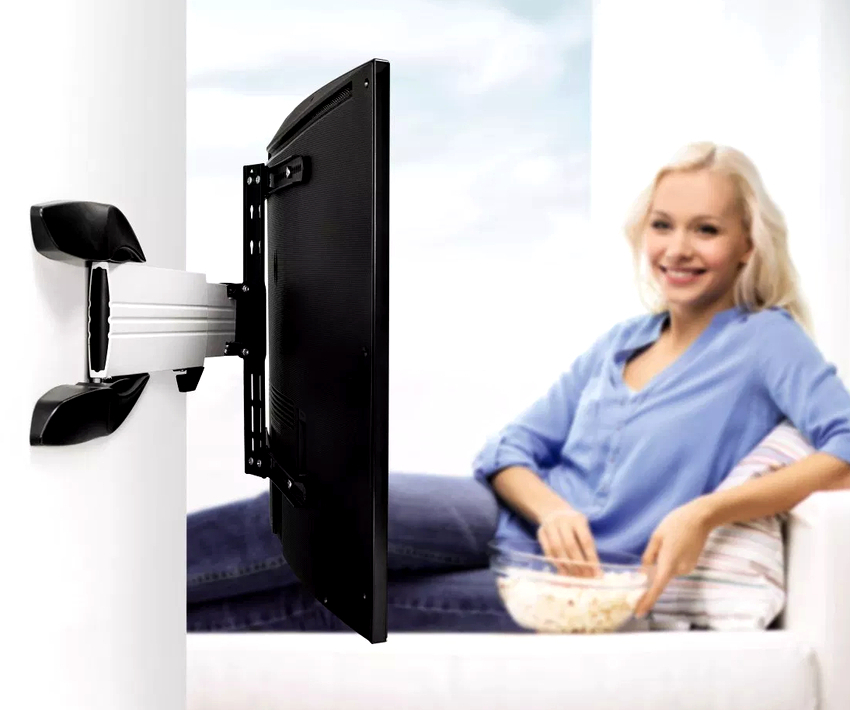
Placing the TV on the Wall allows you to save space and money on the purchase of cabinets, cabinets or walls
Important! Before you hang the TV on drywall, you need to be sure that the entire structure, together with the bracket, will not exceed a weight of 15 kg.
The main disadvantages of placing the TV on the wall include the fact that you should think about the location of the outlets in advance. If you do not immediately foresee the location of the device, you will either have to move the outlet or use a long wire, which will then need to be hidden so as not to spoil the appearance of the room. Another negative point is the need to install a small shelf if you need to install a Wi-Fi receiver, game console or connect a laptop to watch a movie near the TV.
The main negative point is the impossibility of transferring the device. After you hang the LCD TV on the wall, there will be holes on the surface from the fasteners, which will not be easy to hide after moving the TV. At this place, you will have to hang some decorative elements or carry out cosmetic repairs.
At what height do you hang the TV depending on the type of room
To understand how to properly hang a TV on the wall, you first need to decide on the choice of a place for installation, choose the height and evaluate the capabilities of the wall. Not only convenience and comfort of use, but also health safety will depend on the height at which to hang the TV on the wall. The more successful the place is chosen, the more pleasure you can get when viewing.
First of all, the choice of location depends on the characteristics of the room in which the device is planned to be used. For example, when deciding on the convenient placement of the screen in the living room, you first need to know exactly where the seating area with a sofa and comfortable chairs will be, because you need to attach the TV to the wall directly opposite this place.
In a living room, the placement of the screen will directly depend on the height of the furniture installed. Before deciding at what height to hang the TV, you need to take into account that the middle part of the LCD monitor should be clearly located at eye level. Only in this case it will be comfortable to sit and look at the screen.
Important! Of course, you will not be able to choose a height that will ideally suit everyone, because each person has a different height. However, if you take the average value of the TV installation height, then it varies from 100 to 140 cm from the floor level.
How to properly hang the TV on the wall: installation height in the kitchen and bedroom
If we are talking about installing a TV in the bedroom, here the preferences will be slightly different, because in the room the viewing is carried out not sitting on the bed, but mostly lying down. How to properly hang your TV on your bedroom wall? The height from the floor, which will be ideal in a particular case, can be determined by experiment:
- First way. Lie on your bed and try to choose a more comfortable viewing position for yourself, lie down for a little while to relax. As a rule, the eyes will be focused on a certain point, where the device is then attached.
- Second way. An impromptu screen (this can be a large poster or drawing) is installed in the most suitable place, and then they sit on the bed to determine whether it is conveniently hung. It is necessary to move the image until the ideal height is reached.

Installation height TV in the kitchen is determined based on safety and the amount of free space
Typically, the LCD monitor is mounted slightly higher in the bedroom than in the living room.It is important not to forget about the warnings of doctors, who do not recommend watching TV for a long time in a fully recumbent position. This is due to the fact that there is a risk of developing diseases of the musculoskeletal system.
If we are talking about the kitchen, then watching TV in this room is more often episodic. The device is mainly used not for viewing, but for listening. Therefore, the installation height is primarily determined in terms of safety and the amount of free space in the kitchen.
In general, installers recommend in kitchens where small children or large gatherings of people are frequent, to install the TV at the highest possible height - 2 m or higher. Sometimes ceiling brackets are used for this purpose, allowing the TV to be raised as far from the floor as possible. Mounting the TV on the wall in this way will help prevent the device from accidentally tipping over.
Important! Before you hang the TV on the wall in the kitchen, you need to first think over the location of the heating devices, taking into account that the screen is as far from the stove as possible.
How to hang a TV on the wall: choosing the optimal distance, rules and recommendations for placement
In addition to the height, it is also important to choose the right distance to the screen, because not only the load on the organs of vision will depend on this, but also the amount of time that can be spent near the screen without provoking eye fatigue. Ophthalmologists note that the optimal distance to the screen is equal to the sum of three or four display diagonals. You should not plan to install the TV close to other furniture so as not to disturb the geometry of the picture, because the eyes will get tired faster and the image may blur. Recommendations for screen placement in relation to the diagonal are as follows:
- diagonal TV 32 inches is advised to hang at 2.5 meters from the eyes;
- 40 ”- no closer than three meters;
- a home theater with a screen larger than 55 inches should be placed no closer than four meters away.
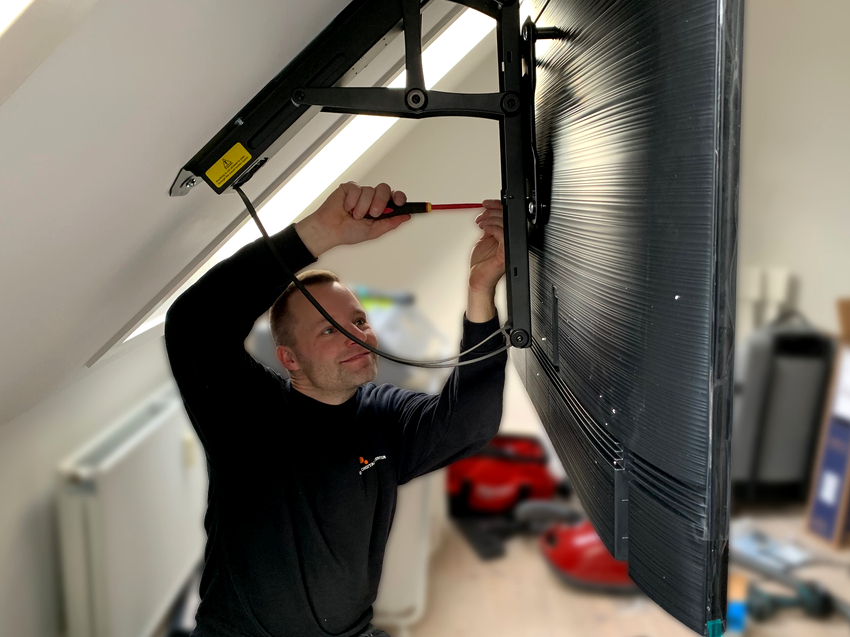
In addition to height, it is very important to choose the right distance to the TV, because the load on the eyes will depend on this.
Other rules to consider before mounting the TV on the wall:
- The device cannot be installed in an enclosed space, because in case of insufficient ventilation it will constantly overheat, which will lead to its rapid failure.
- Do not place the screen near heating objects, which include hobs, artificial and real fireplaces, heaters.
- Before you hang the TV on the wall, make sure that it is strong enough and that the mounts are correct.
It is not recommended to place screens near or opposite a window opening, since daylight contributes to the appearance of glare on the screen, which will impede comfortable viewing. If it is not possible to find an alternative place, it is recommended to place blackout curtains or lightproof shutters on the windows, which are lowered if necessary.
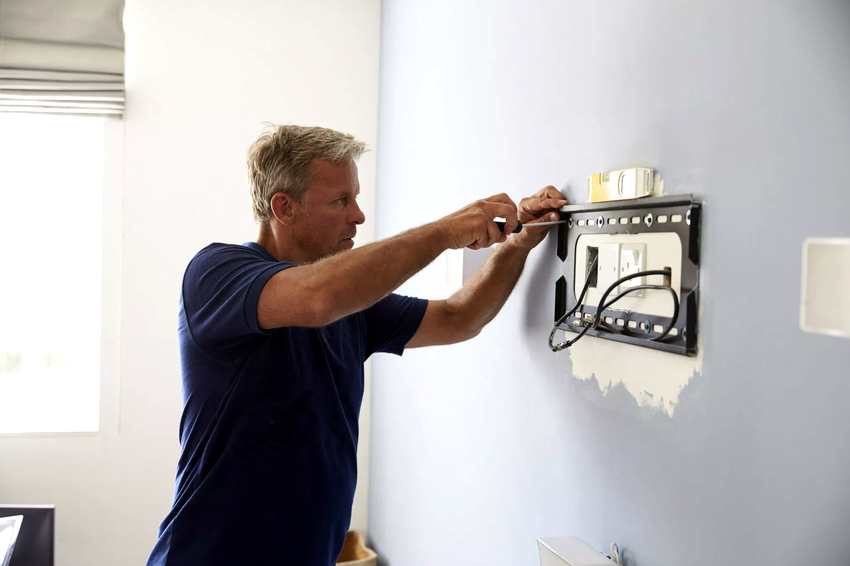
When installing a TV in the bedroom, it must be borne in mind that in this room the viewing takes place not sitting on the sofa, but lying on the bed.
Helpful advice! The size of the screen must be selected depending on the area of the room. No need to try buy a TV maximum size, because looking at a large screen in a small room for a long time will not work, because your eyes will get tired.
Brackets for installing a TV on the wall: types, advantages and disadvantages
You can hang a Samsung TV on the wall, like any other plasma model, using a special bracket used as a mount.Depending on the type and method of fixation, the following types of brackets are distinguished:
- fixed;
- inclined;
- retractable;
- ceiling;
- tilt and swivel.
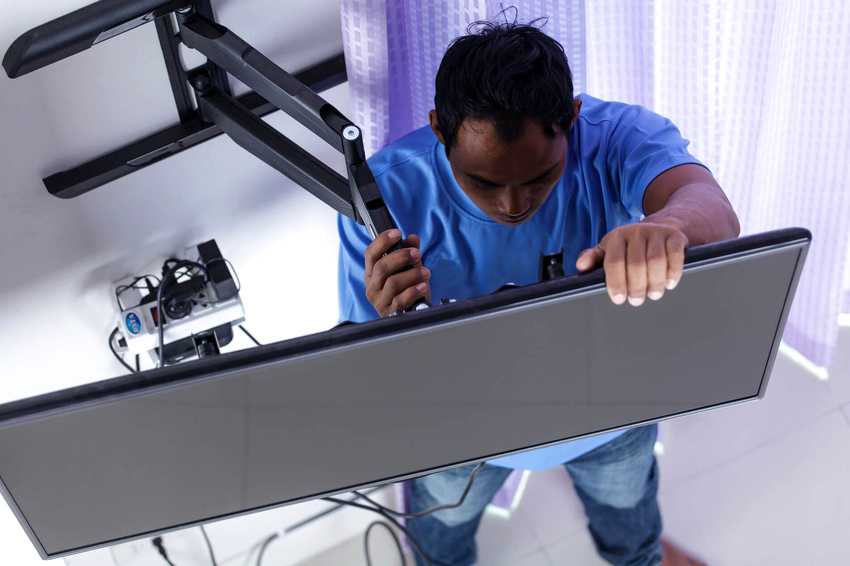
The ability to adjust the position of the bracket is what distinguishes mounts for TVs between themselves
The main thing that distinguishes various types of fasteners is the ability to adjust the position of the structure on the wall. The fixed bracket is one of the simplest options, which allows you to hold the TV only in a vertical plane. The negative aspects of using this type of mount include the impossibility of adjusting the position of the screen due to the absence of moving elements. However, the main advantage follows from this negative moment - the high reliability of the fastening. Another advantage is the low cost of the product.
Related article:
Bracket for TV on the wall swivel retractable: selection and installation
Bracket types and their characteristics. How to choose the right one and mount it on the wall.
Characteristics and description of other types of brackets:
- Inclined. By hanging the TV on the wall (on a bracket of this type), it will be possible to change the angle of the screen, which is especially important in the case of a high placement. And also by tilting, you can slightly change the distance to the device. The disadvantage of using is the lack of the possibility of horizontal adjustment.
- Swivel and tilt. With this type of mount, you can adjust the position of the LCD monitor both horizontally and vertically. It is especially convenient to use such brackets in a large room. Users note the great bulkiness of the design and the rather high cost of the product.
- Retractable. Refers to multifunctional types of fasteners, because with its help you can not only change the tilt of the screen horizontally or vertically, but also change the position of the monitor relative to the wall surface. The design is rather large and is not recommended for installation in a small room.
- Ceiling. Ideal for a room with high ceilings or for a kitchen. Using the ceiling type of bracket, you can change the position of the screen 360˚, and vertically, the tilt angle changes up to 90˚. In most cases, these brackets are used in spacious studio kitchens combined with a living room, as well as in public places such as cafes or bars.
How to choose a mount and how to hang a TV without a bracket on the wall
The choice of a bracket is an important task on which the reliability of the future structure will depend. Therefore, before buying a TV stand on the wall, you need to inquire about the availability of a warranty card, as well as study the features and characteristics of the product. It is very important here that the bracket is designed to support the weight of the TV with a margin, it is good when the tensile strength is 5-10 kg more than the weight of the screen itself with the mount. The main points to look for when buying a bracket:
- Equipment. It is important to check the availability of all the tools necessary for installation, so as not to detect their absence already during the installation process.
- Mount type. For mounting a widescreen display, it is recommended to choose a swivel arm, which is more expensive but makes the adjustment much easier.
- Additional elements. Some types of brackets include a box used for decorating cables and wires, which will help preserve the appearance of the interior. It is also advisable to buy options with additional shelves and holders for accessories.
- Material and workmanship. The product should not have chips, cracks or voids, and it is also required that it be made of high-quality metal that can withstand heavy loads.
- Remote control presence. Some models of brackets are equipped with a remote control that allows you to adjust the position of the device. Without getting up from the sofa, it will be possible to correct the angle of inclination and change the rotation of the screen, which is especially important when installing the TV opposite the window.

You can hang the TV on the wall without a bracket thanks to special fixtures on the back of the case
Helpful advice! The optimal angle of the TV is considered to be in the range from –15 to +15 degrees..
In addition to using a bracket, many flat panel TVs over 42 inches are designed to be installed without the need for special brackets. Manufacturers have foreseen the possibility of mounting the device without the use of additional parts.
To hang the screen, there are special lugs resembling grooves on the back of the case. It is they who are used to put the plasma on the fasteners screwed into the wall. In this case, the process of installing the TV is no different from fixing a picture or a framed photograph on the wall. Here it is important to choose the right fasteners that can withstand the weight of the TV, as well as pre-assess the capabilities of the wall. And also, if you have special grooves, you can try to install the TV on a bracket made at home.
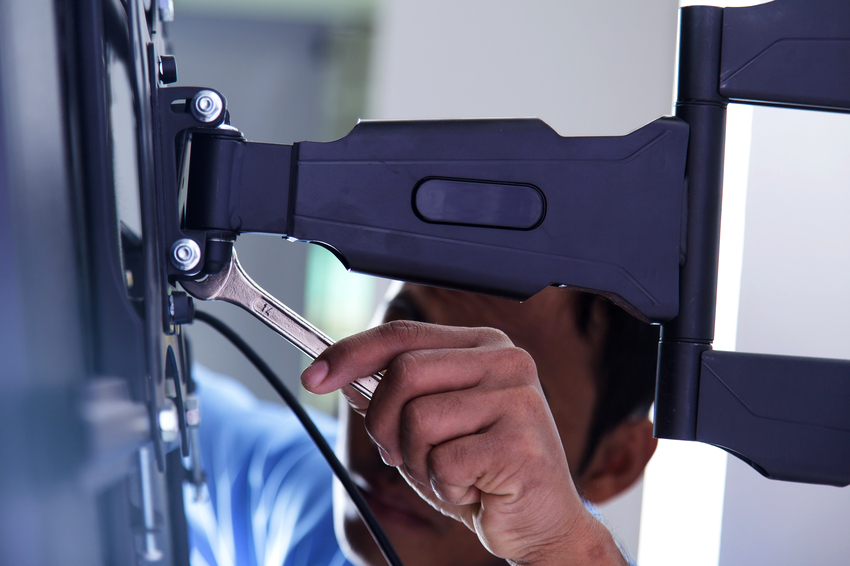
When choosing a bracket, you must pay attention to the fact that the mount is designed to support the weight of the TV with a margin
How to hang your TV on a drywall and other types of materials
There are many conflicting opinions on how to hang a TV on a drywall blank wall. Some experts argue that in order to correctly fix the screen on such a wall, it is enough to use a special dowel, the so-called "butterfly". Others say that this mounting option is suitable only for installing a screen weighing up to 10-15 kg, because, having hung a TV on a plaster wall, the weight of which is greater than the specified value, you need to be prepared for the risk of wall destruction.
Based on most recommendations, in order to securely fix the device on a wall made of drywall sheets, you need to choose dowels of such length, which is enough to attach not to the sheet, but directly to the metal profile of the wall. In this case, you can hang the TV on a plasterboard wall either with a stud-screw or with any other anchor. To determine the correct length of the stud, you need to consider the thickness of the drywall sheet, the distance to the wall, and the required depth to which the anchor must enter the wall.
Helpful advice! The deeper the anchor is screwed in, regardless of the type of building material from which the walls are made, the more mass it can withstand, because the main load will fall on the load-bearing wall, and not on the drywall sheet.
Another difficult option is the presence of a false plasterboard wall, on which it is planned to place the TV. Here the opinion of the installation experts is unanimous, and it follows from it that an expensive screen to be attached to such a wall is categorically not recommended. In this situation, it is advised to purchase a special stand with a bracket. An advantage is the fact that the position of the TV, due to the mobility of the structure, can be easily changed and not think about the holes left on the wall.
As for walls made of other materials, installation to a wooden, concrete wall or to a solid brick surface is considered the easiest. These materials are very durable and can withstand a lot of product weight. In this case, you need to choose the right anchor or dowel, as well as firmly embed the mount into the wall.
Quite often the question arises of how to hang a TV on a wall made of foam blocks, hollow bricks, cinder blocks or wood concrete, the inner parts of which differ in cavities and voids. In such a situation, one cannot do without a reliable chemical anchor, which fills all internal voids, which ensures the safety of the installation and preserves the integrity of the screen.
How to mount a TV on the wall: photo in the interior
After the optimal installation site has been selected, the bracket and the necessary fasteners have been purchased, they proceed directly to the installation process. If there is no prior experience in installation, then you must clearly follow the instructions for the bracket, and you also need to check the availability of such tools:
- puncher and drills (if the wall is made of plasterboard);
- screwdrivers;
- pencil;
- level.
The place where you plan to install the monitor must be marked with a simple pencil. It is important to first make sure that electrical wires do not pass through the wall so as not to damage them and get unnecessary problems. Installation begins by placing the bracket against the wall and marking where the plates will be mounted. After making the marks, check the symmetry with a spirit level to prevent the TV from tilting, which could cause the unit to fall.
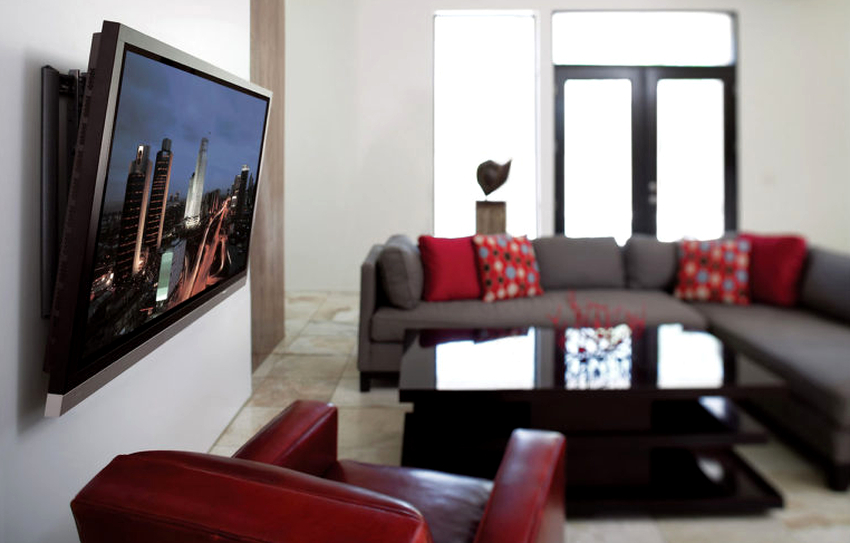
By properly hanging the TV on the wall, you can create optimal conditions for watching your favorite films and programs.
Then you need to drill holes in the wall with a puncher and insert the dowels inside, on which the mounting plate is installed and fixed. The counter plate is then mounted on the back of the TV. This is usually done using the supplied bolts. After both plates are installed, you can start attaching the screen to the wall. In this case, it is better to have an assistant, because it is more convenient when one person is holding the TV, and the second at this time aligns the grooves and tightens the fasteners.
When the TV sits tightly on the bracket, you can start decorating the cables, often interior stickers are used for this, allowing you to turn the TV cable into a real tree. You can also hide the cable in a special channel, which is mounted on the wall and painted in the desired color. The most successful option is considered to be the wiring hidden in the wall, for this, strobes are made in the walls, where the wiring is hidden.
By correctly positioning the flat screen on the wall, it will be possible to create a comfortable environment for watching your favorite movies and programs, while not taking up precious room space. To make the purchase enjoyable, you must first find the most suitable place for the screen and not try to buy a TV, the diagonal of which does not correspond to the area of the room. Even with minimal skills, it will not be difficult to install the device yourself.
